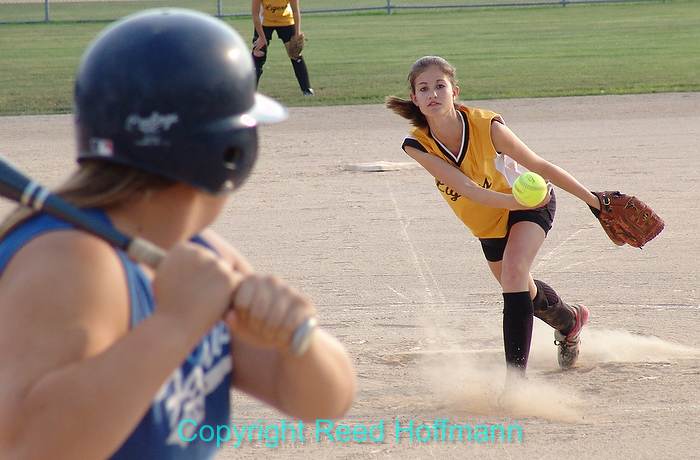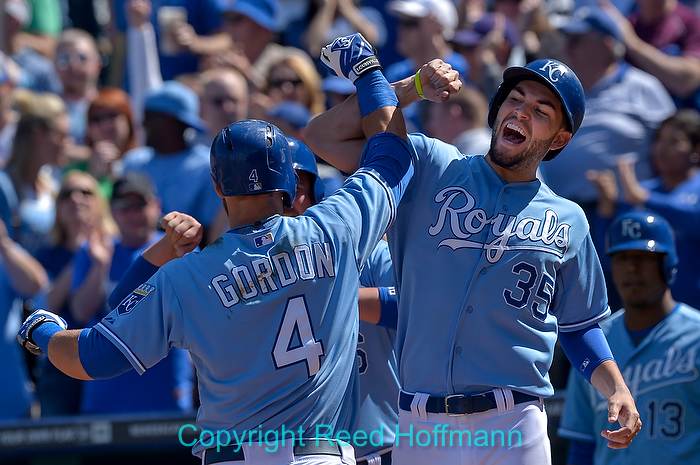With spring upon us, now’s a great time to talk outdoor action photography. Sports in particular are fun to shoot because you never know what might happen, and what picture might result. Of all the sports to shoot, I think baseball’s the most difficult because there’s relatively little action, and what there is usually happens very, very quickly. That means not only do you have to pay attention to exposure and framing, but more importantly, you have to anticipate. Today I’m going to talk about how to do sports photography, with baseball as the subject.
In the early days of digital, people complained about shutter lag with point-and-shoot cameras. It could take several seconds after you pushed the button before the camera took the picture. That was because of autofocus, and thankfully has gotten faster. Single lens reflex cameras were much quicker because of the different autofocus system used. But no camera, even today, can shoot instantly – there’s always some shutter lag. Because of that, every good sports photographer understands the importance of anticipating the action. If you wait until you see that moment and then press the shutter button, that moment’s gone. So action photography requires learning to anticipate, and doing that well is mostly a matter of practice and understanding the game.
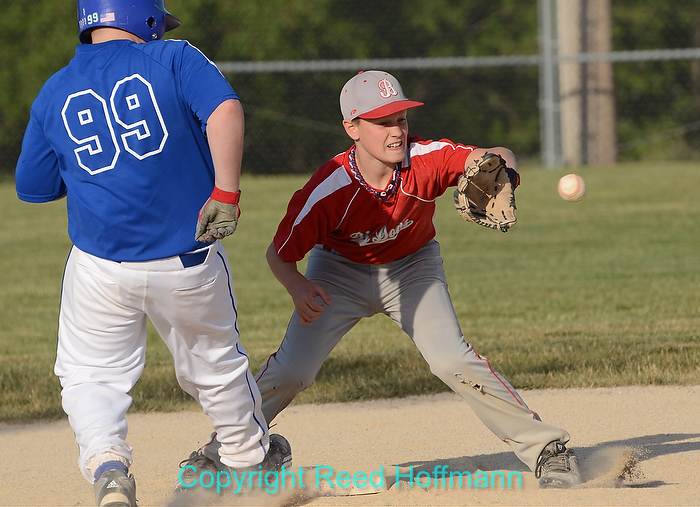
You have to press the shutter button before the ball gets there if you want to catch it in the air. Anticipation’s the name of the game. Nikon D7000, Nikon 70-300mm f/4.5-5.6 lens, 500 ISO, 1/2000 at f/6.3, -.3 EV in Aperture Priority. Photo copyright Reed Hoffmann.
Anticipating fast action is one thing, stopping it is another. Fast shutter speeds can do that, especially once you’re at 1/1000 second or above. To do that you usually need good light (daylight). If you want to make good sports pictures at night (or indoors), then you’ll need a camera with good high ISO capability (good quality at up to 4000), plus a “fast” lens. That means a lens with a maximum (widest) aperture of at least f/2.8. And unless you’re going to be close to the action, a telephoto’s required too. But be forewarned – “fast” telephoto lenses, especially zooms, are expensive.
An added advantage to a fast lens is the autofocus will be faster too. The more light a lens lets in, the better the camera’s autofocus will perform. I once heard a photographer who worked for Sports Illustrated tell an audience, “If you want good action pictures, go out and buy the most expensive cameras and lenses.” Sadly, that’s pretty true, but you can do a good job with less expensive gear if you’re shooting in daylight, and follow a few simple guidelines;
Exposure – As mentioned above, if possible, you want to shoot at shutter speeds of 1/1000 or higher. You can get some good pictures at speeds as low as 1/500, but faster’s almost always better for action. In daytime that’s not hard to do, by either raising your ISO and/or opening the aperture of your lens.
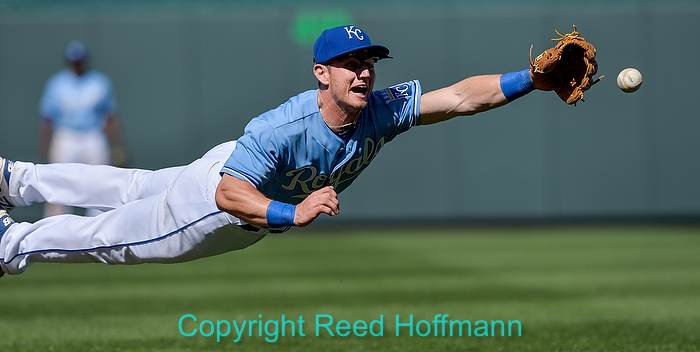
If you want to stop fast action, like this dive for a line drive, you better be shooting at a high shutter speed. And the contrast was reduced by having the camera set to “Neutral” Picture Control with Active D-Lighting at “High.” Nikon D4, Nikon 500mm f/4 lens, 200 ISO, 1/3200 at f/5.6, -.3 EV in Aperture Priority. Photo copyright Reed Hoffmann.
Telephoto – Since you’re rarely close to the action, a telephoto lens is a necessity. A focal length of at least 200mm is often needed, although longer is almost always better. I have the luxury of owning some very long lenses, but a consumer grade 70-300mm will usually do a good job as long as you have enough light (because it doesn’t have a fast aperture).
Focus – You’re going to want your camera’s autofocus to track the action as it happens, and that means following that action at changing distances. To accomplish that, make sure your autofocus mode is set to AF-C for “Continuous” tracking. If using a Nikon camera, also be sure it’s set to “Dynamic,” which lets it use surrounding points to try to maintain focus. I usually choose Dynamic 21, 39 or 51, depending on the Nikon camera I’m using and the action I’m shooting.
Continuous Release – All of today’s cameras can be set to “Burst” mode so you can press the shutter button down, hold it down, and have the camera continue shooting pictures. Most cameras can do that at around five frames per second, but more expensive ones can often shoot faster. Make sure and turn on that continuous release mode to take advantage of it.
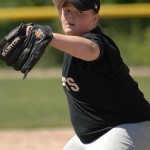
A camera with a fast burst mode means you can shoot an action sequence. Nikon D2X, Nikon 80-400mm f/4.5-5.6 lens, ISO 320, 1/1000 at f/5.6, EV -.3, Aperture Priority. Photo copyright Reed Hoffmann.
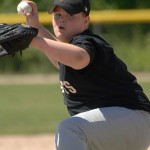
A camera with a fast burst mode means you can shoot an action sequence. Nikon D2X, Nikon 80-400mm f/4.5-5.6 lens, ISO 320, 1/1000 at f/5.6, EV -.3, Aperture Priority. Photo copyright Reed Hoffmann.
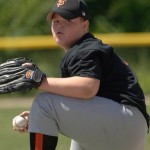
A camera with a fast burst mode means you can shoot an action sequence. Nikon D2X, Nikon 80-400mm f/4.5-5.6 lens, ISO 320, 1/1000 at f/5.6, EV -.3, Aperture Priority. Photo copyright Reed Hoffmann.
Background and Framing – There’s more to good sports photography than just capturing a good moment. As with any photography, background is important too. Distracting, confusing or overly bright backgrounds can take away from the impact of the photo. Choose your shooting position not just based on what you want to shoot, but also on what the background will be from that spot. And the tighter you can frame the shot, the more impact it will have. Sometimes you have to shoot loose because you don’t have a long enough lens, or simply to make sure you get the picture. But tighter framing results in stronger images.
Contrast – If you’re shooting in full sunlight, contrast can be a problem. If a team has white uniforms, and they’re wearing hats, your exposure can come down to either having detail in those uniforms (not overexposed) or being able to see their faces. Of course, you’d like to have both. One solution is to shoot from an angle where the athletes are backlit. Another is to choose a processing setting in your camera to reduce the contrast (for Nikons that would be done by setting Picture Control to “Neutral”). Finally, some cameras offer a menu choice to help reduce contrast. In Nikons that’s called “Active D-Lighting” (and other manufacturers often have something similar). Setting ADL to “Auto,” or even “High” can help. However, do some testing of those setting to make sure the resulting pictures look normal. At very high settings those effects can be noticeable, and give your photos an over-processed look.
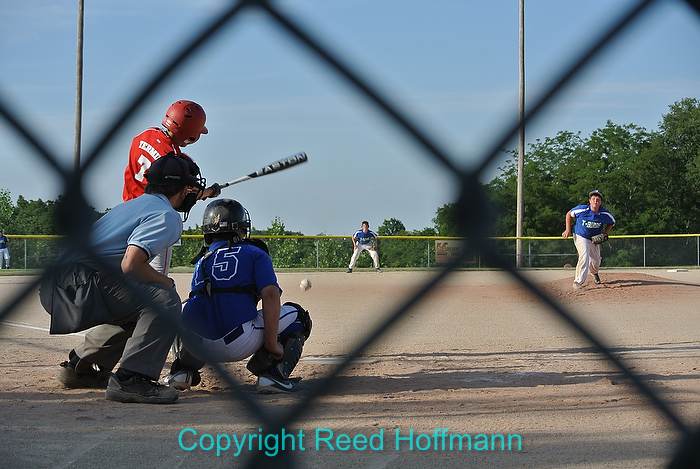
Look for unusual angles or different ways to compose your pictures. In this case the fence frames the pitcher throwing against the batter. Nikon 1 V1, Nikon 10-30mm lens, ISO 100, 1/500 at f/5.6, EV -.7, Program Mode. Photo copyright Reed Hoffmann.
Creative – Sports photography is usually about catching peak action and freezing it, but there are other good pictures to be made as well. Using shutter speed creatively means you can choose to intentionally blur action. “Panning” is where you use a slow shutter speed and follow the action as it crosses in front of you. That movement of the camera will create more blur in the background than in the subject. And some of the best sports photos ever made are of reaction to what’s just happened, not the action. Expressions and emotions are universal, and seeing them on athlete’s faces gives the viewer a better understanding of what they’re feelings, be it joy, frustration, anger or happiness. Finally, there are good pictures to be had between plays, as well as off the field. Being a good photographer means staying aware of everything going on around you, always on the lookout for good pictures.
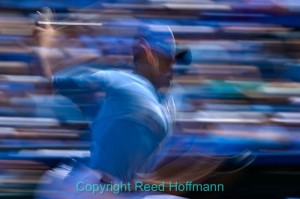
While your goal is normally to stop action, you should also try slower shutter speeds occasionally for creative effect, like this pan shot. Nikon D4, Nikon 500mm f/4 lens, ISO 50, 1/13 second at f/22, EV -.3, Aperture Priority. Photo copyright Reed Hoffmann.
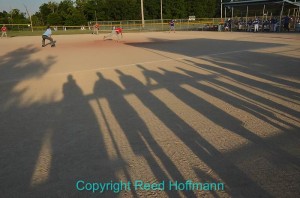
The shadows here give you a feel for the families looking on , and lead you into the action. Nikon D5100, Nikon 10-24mm f/4 lens, ISO 500, 1/1600 at f/7.1, EV -.7, Aperture Priority. Photo copyright Reed Hoffmann.
Shooting sports can be a lot of fun, and lets us take advantage of photography’s ability to freeze a moment in time, to be viewed later. It has drama, peak action, emotion and storytelling. And best of all, good pictures can be made whether you’re at a t-ball game, high school or professional. So get your gear, go over those settings and get out there. Good pictures await!

